Cost Insights on Resizing Gemstone Jewelry at Blue Nile
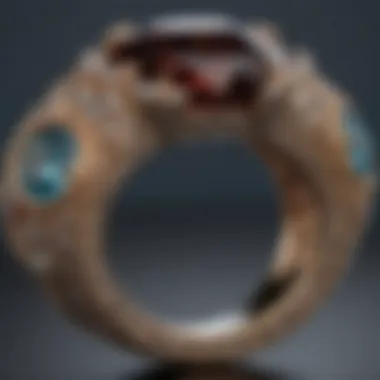
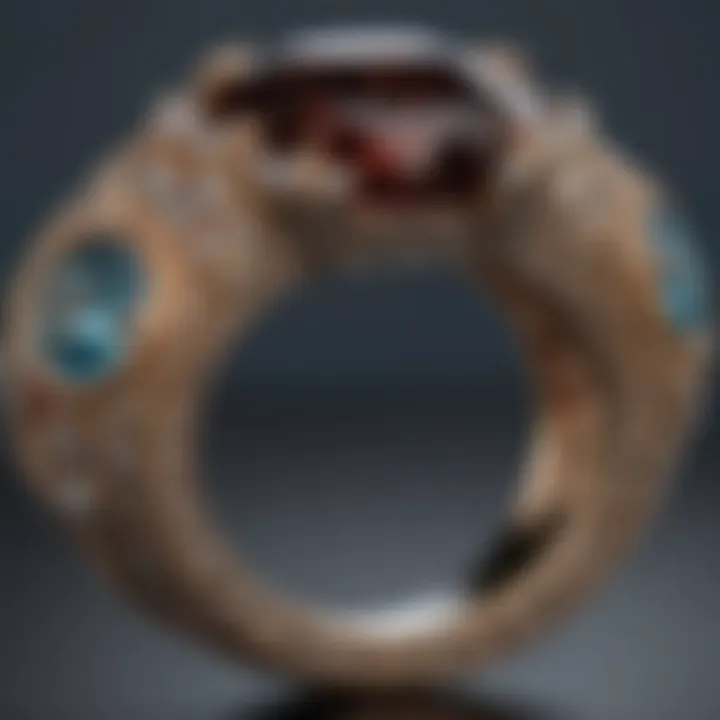
Intro
Resizing gemstone jewelry can be a delicate dance, one that involves understanding not just the aesthetic adjustments but also the financial implications. When it comes to resizing pieces acquired from Blue Nile, a leading online retailer, it’s crucial for jewelry enthusiasts and collectors to grasp the complexities involved. Whether you have a sentimental heirloom or a recent purchase, the cost of resizing will depend on various factors that this article will unpack. By exploring the nuances of gem specifics and comparing Blue Nile’s services against industry standards, readers will gather valuable insights to make informed decisions.
Gemstone Overview
When delving into the world of gemstone jewelry, it’s essential to grasp exactly what a gemstone is and what sets each one apart.
Definition and Characteristics
A gemstone, broadly classified, is a precious or semi-precious mineral that is cut and polished for use in ornaments and adornments. These stones are valued for their beauty, rarity, and durability. The most celebrated gemstones, such as diamonds, rubies, and emeralds, exhibit remarkable hardness and stunning color variations. But it’s not just their physical attributes that matter; each gemstone tells a story and carries a history that often enchants its owner.
Classification of Gemstones
Gemstones generally fall into two main categories: precious and semi-precious. Precious gemstones typically include those famed for their rarity and appeal, such as:
- Diamond: Known for its unmatched hardness and brilliance.
- Ruby: Celebrated for its rich crimson color and symbolism of passion.
- Sapphire: Often associated with wisdom and nobility, available in various colors.
- Emerald: Valued for its deep green hue and often connected to renewal and growth.
On the other hand, semi-precious stones, although equally charming, can be more abundant. Examples might include amethyst, garnet, and aquamarine.
The classification often affects how resizing costs are calculated, significantly in relation to value and the specific care needed during the process. Some gemstones, due to their composition and fragility, require specialized skills to resize, leading to potentially higher costs than resizing a durable diamond ring.
"Understanding the properties of your gemstones can profoundly influence the decisions surrounding resizing and the cost attached to it."
Historical Significance
The charm of gemstones extends beyond their physical characteristics; they carry deep historical significance that shapes how they are perceived today.
Ancient Uses and Cultural Importance
From the ancient Egyptians, who adorned themselves with turquoise and lapis lazuli, to the Chinese jade lovers, gemstones have played pivotal roles in cultures throughout history. They were often believed to possess mystical properties. For instance, ancient Greeks associated sapphires with Apollo, the god of prophecy, while rubies were thought to ensure protection in battles.
Myths and Legends Surrounding Gemstones
Various myths have imbued gemstones with meanings and significance over the ages. One popular legend involves the belief that diamonds can only be worn by those deemed virtuous. Conversely, many cultures ascribe protective qualities to amethyst, suggesting that it wards off negative energies and promotes tranquility. Such narratives add an enchanting layer to the aesthetic value of gemstones and heighten their allure for collectors and jewelry designers alike.
Prologue to Blue Nile and Resizing Services
When it comes to buying and maintaining gemstone jewelry, Blue Nile stands at the forefront as a reputable online retailer. The significance of resizing services cannot be overstated, particularly for collectors and enthusiasts who want their treasured pieces to fit comfortably and securely. This section unpacks how Blue Nile's expertise enhances the longevity and wearability of your jewelry while also examining the rationale behind resizing.
Overview of Blue Nile's Jewelry Offerings
Blue Nile has carved out a niche in the online jewelry market, offering a wide array of items that cater to various tastes and preferences. From engagement rings adorned with dazzling diamonds to elegantly crafted gemstone necklaces, their selection is impressive. Notably, Blue Nile prides itself on providing jewelry that is both high-quality and ethically sourced, which resonates with a growing segment of environmentally conscious consumers.
Apart from rings, necklaces, and earrings, they have an extensive collection of bracelets that can suit any occasion. Customers can also pick and choose gemstone qualities, ensuring that every piece not only meets aesthetic desires but also aligns with personal value systems.
Their resizing services are vital, considering that many online shoppers may not have access to handling the jewelry before purchasing. Perhaps an engagement ring seems perfect at first glance, but what can happen when the size is slightly off?
Importance of Resizing Jewelry
Resizing jewelry is not just a logistical necessity but a way to preserve the emotional value of a piece. A ring that does not fit well can lead to discomfort and even the potential loss of the jewelry. Imagine a cherished wedding band that continually slips off during daily activities—it's a situation many hope to avoid.
Moreover, resizing goes beyond mere fit; it speaks to the relationship between the wearer and the jewelry. When a piece fits properly, it enhances the experience of wearing it. The contours of a well-sized ring can draw attention to its shimmering gemstone, making a statement without uttering a word.
In essence, the resizing service offered by Blue Nile is more than a transactional process. It represents customer service at its best, ensuring that every individual can wear their jewelry comfortably, confidently, and beautifully.
"The right fit elevates a piece of jewelry from mere adornment to a treasured companion in your journey of life."
Factors Influencing Resizing Costs
Understanding the costs tied to resizing gemstone jewelry at Blue Nile is essential not simply for budgeting but also for ensuring you get the service that suits your needs best. Resizing is not just a matter of adjusting the fit; it involves various elements that directly affect pricing. Each piece of jewelry carries its own unique characteristics that must be considered. By recognizing these factors, customers can make informed decisions about their jewelry care.
Material of the Jewelry
The material of the jewelry plays a huge role in the costs associated with resizing. Precious metals like gold or platinum often require more care and specific techniques for resizing than, say, sterling silver or base metals. For instance, a solid platinum ring can take more time and resources to resize due to its density and strength.
- Gold: Resizing a gold ring generally incurs a moderate cost. The karat of gold—be it 10k, 14k, or 18k—also influences the price. Higher karats mean more gold content and, subsequently, a higher cost.
- Platinum: This is typically the most expensive material to resize. Its density and resistance to scratching require skilled labor, which can lead to steeper fees.
- Silver: Being softer and easier to manipulate, resizing silver is usually less costly. However, over time, repeated resizing can wear it down.
Understanding these material distinctions helps you gauge potential resizing costs right from the start.
Complexity of the Design
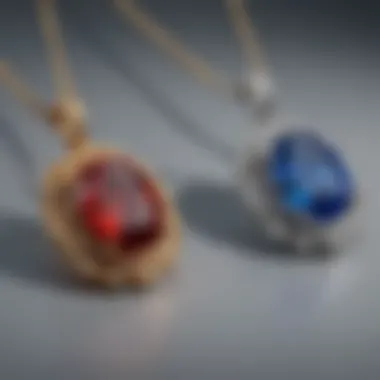
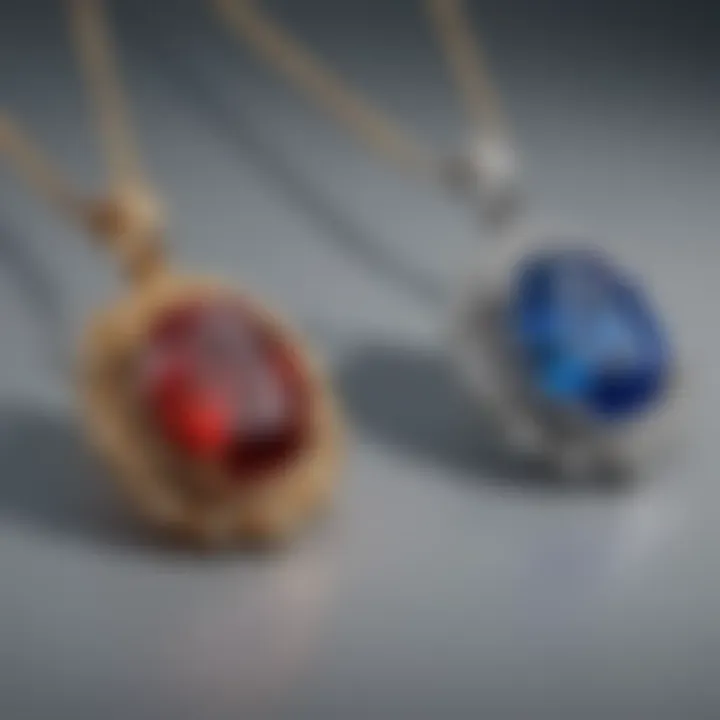
The intricacy of the design is another significant factor when thinking about resizing costs. A simple band is much easier to resize than a highly detailed or ornate ring. Designs that feature filigree, engraving, or setting configurations can complicate the process.
- Simple Designs: Rings with no added features typically have lower resizing costs. They can often be resized quickly, which is reflected in the pricing.
- Intricate Designs: For rings that boast complex designs, additional time and expertise are required, thus raising the price. If a ring has multiple stones or an elaborate setting, ensure to discuss how these elements will be handled in the resizing process.
Types of designs influence not only the labor involved but also the potential risk to any precious stones involved during the resizing.
Type of Gemstone Involved
The type of gemstone set in a ring or piece of jewelry is crucial when it comes to resizing considerations. Different gemstones are not only valued differently but also vary in their durability. For example, a delicate opal might need special handling compared to a hard diamond.
- Hard Gemstones: Diamonds, sapphires, and rubies are typically robust and can endure setting adjustments without much concern.
- Soft Gemstones: Stones like opals or pearls are more sensitive and might require more finesse during the resizing process, thus elevating costs.
When discussing resizing with Blue Nile, you should clarify the implications of your specific gemstones. Being well-informed on what your jewelry incorporates will assist in managing your expectations and costs effectively.
In summary, factors such as the material, design complexity, and gemstone type all converge to influence the final resizing costs at Blue Nile. By understanding these elements, customers can make thoughtful choices that align with both their aesthetic desires and their budgets.
Types of Resizing Services at Blue Nile
Understanding the types of resizing services available at Blue Nile is crucial for anyone considering adjustments to their gemstone jewelry. Different pieces may require various methods and expertise, and knowing exactly what to expect helps ensure that each cherished item gets the attention it deserves. This section outlines the most common services offered and what they entail, shedding light on some important factors associated with jewelry resizing.
Shrinking and Enlarging Rings
When it comes to rings, shrinking or enlarging them can be a touchy subject. Not every ring is a one-size-fits-all, and mistakes can lead to disappointments. At Blue Nile, resizing rings involves both removing or adding metal to achieve the desired size.
Key Characteristics:
- Precision: This task requires skilled craftsmanship to maintain the integrity of the ring, especially if it features intricate designs or gemstones.
- Material Compatibility: Different metals, such as platinum, gold, or silver, can require distinct approaches, affecting costs and time.
Considerations:
- Enlarging a ring may mean additional costs due to the need for new materials, while shrinking may involve the removal of existing material, which can be a more streamlined process.
Resizing Other Jewelry Types
While rings often steal the spotlight, there are other jewelry types, like bracelets and earrings, that may also need resizing services. Let’s break down how Blue Nile handles each.
Bracelets
Adjusting the size of bracelets isn't just about making them longer or shorter; it often includes altering the clasp or links that hold the piece together.
Key Characteristic:
- Flexibility: Bracelets, especially those with removable links, can be resized easily, but this process requires attention to detail to ensure that the final piece retains its overall style and structure.
Benefits:
- Resizing bracelets at Blue Nile allows you to maintain the original design while creating a fit that's just right, making it a popular request among customers.
- The option to add or remove links is especially beneficial for chains and bangles, allowing wearers to enjoy comfort without sacrificing their cherished item's beauty.
Earrings
When resizing earrings, the considerations again differ from rings or bracelets, as the focus shifts to balance and wearability.
Key Characteristic:
- Symmetry: Whether altering the length of dangles or adjusting hoops, ensuring that both pieces match is essential for aesthetic appeal.
Considerations:
- The adjustment process can affect how the earrings sit on the earlobe, enhancing or detracting from their overall charm. With Blue Nile's expertise, customers can rest assured that the final result will be stylishly balanced.
Average Resizing Costs at Blue Nile
When it comes to resizing gemstone jewelry, understanding the costs associated with this service at Blue Nile is paramount for patrons. It not only helps you budget for what can be a significant yet necessary alteration, but also allows you to appreciate the craftsmanship involved in these services. The resizing costs are a layered subject, influenced by several factors such as the type of jewelry, materials used, and the intricacy of the design.
Breaking down these costs into their respective components can shed light on what one might expect when considering a resizing project. In essence, this section aims to demystify the pricing landscape at Blue Nile, providing potential customers with a clear picture of the financial commitment involved for the transformation of their jewelry.
Standard Pricing for Resizing
Standard pricing for resizing at Blue Nile typically involves a straightforward fee structure. Generally, the costs start from a base price, which can be as low as $50 for simple rings. However, this initial estimate may climb based on complexity and material type.
Here's a quick summary of standard pricing structures:
- Basic Ring Resizing: Starts at around $50.
- Complex Designs: May range from $100 to $150 and up, depending on the design intricacies.
- Other Jewelry Types: Bracelets and earrings often fall in a similar price bracket, but may require individualized assessments.
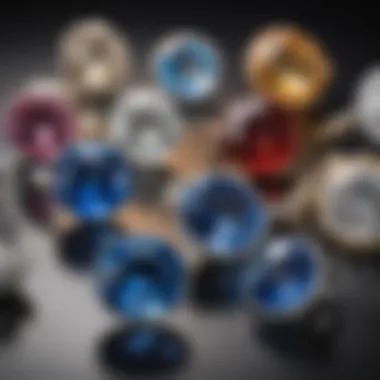

Cost Variation by Material Type
The material of the jewelry significantly influences resizing costs. Different metals possess distinct properties, requiring varying techniques during resizing. For instance:
- Gold Jewelry: Resizing generally incurs an additional cost due to gold's malleability, often running between $50 to $120 depending on karats and design.
- Platinum Jewelry: Given its density and strength, resizing platinum may start at $80 and can surpass $200 for highly intricate pieces.
- Silver Jewelry: Tends to be more affordable, often clocking in at $30 upwards, but the final price can escalate due to design considerations.
Each material demands a monitor in skill and care, which is why these variances in costs exist.
Additional Costs and Fees
Apart from the basic resizing price, customers should also be mindful of potential extra charges that may arise:
- Gemstone Replacing or Resetting: If the resizing affects the gemstones, there may be a fee to realign or replace them.
- RUSH Service Fees: If time is of the essence, there are additional service charges for expedited resizing.
- Shipping Costs: For online transactions, shipping the jewelry to and from Blue Nile can add up. It's best to check their current rates.
A wise buyer keeps these approximate costs in mind to avoid any unwelcome surprises.
Taking an informed approach regarding these resizing costs allows jewelry lovers to make prudent decisions and keep their treasured pieces fitting just right.
Comparison with Competitors
When it comes to resizing gemstone jewelry, understanding how services stack up against each other is crucial. This section sheds light on what alternatives exist beyond Blue Nile and how they cater to various needs, preferences, and budgets. Knowing these comparisons helps consumers make shrewd choices that align with their standards of quality, service, and overall satisfaction.
Resizing Services at Other Jewelers
Independent Jewelers
Independent jewelers bring a unique flavor to the table when it comes to resizing services. They are often local artisans with a wealth of experience and a personal touch. What sets independent jewelers apart is their capacity to offer customized services. You can walk in with your specific requirements, and they can tailor the work to meet what you envision, often making adjustments on the spot.
Key characteristic: Personal attention—visiting an independent jeweler often feels like consulting with a friend rather than a faceless company.
However, there are some trade-offs. Since independent jewelers may not have the same reputation as larger businesses, consumers might hesitate about quality assurance. Yet, the laid-back atmosphere combined with skilled craftsmanship can turn daunting resizing tasks into memorable experiences.
Advantages:
- Personalized consultations
- Flexibility in service
- Supporting local businesses
Disadvantages:
- Potential variability in pricing
- Less standardized service
Online Retailers
With the rise of e-commerce, online retailers now offer resizing services by sending rings through the mail for adjustments. This can be a convenient option for those who are comfortable with the digital realm, where you can easily compare prices and services without leaving your home.
Key characteristic: Convenience and the ability to shop around quickly.
However, this method can also raise some red flags. Notably, there’s always a risk of complications during shipping. Furthermore, not being able to see or touch the jewelry before and after the resizing can lead to dissatisfaction, especially if the fit isn’t precisely what you expected.
Advantages:
- Easy price comparison
- Wide variety of options
- Often lower prices due to lower overhead costs
Disadvantages:
- Shipping risks
- Lack of personal interaction
- No immediate feedback
Quality of Service Compared to Blue Nile
When placing Blue Nile’s services next to those from other jewelers, clarity arises—Blue Nile has carved a niche for itself, often boasting a reputation for high-quality craftsmanship and consistency. They offer competitive rates accompanied by the security of a return policy, which many independent shops may lack.
Customer Considerations Before Resizing
When it comes to resizing gemstone jewelry, it's essential for customers to pause and consider a few critical elements before making any decisions. Many individuals rush into the resizing process, thinking they can magically transform a piece to fit better, but a bit of forethought could save considerable heartache later on. It's not just about sizing; it's about understanding the implications of those changes on your cherished gems and the overall integrity of the piece.
There are two main areas that require your attention: assessing the need for resizing and evaluating the gemstone's security. Both are paramount in ensuring that your beloved jewelry remains not only beautiful but also safe.
Assessing the Need for Resizing
Before jumping into the resizing process, ask yourself if it’s truly necessary. The need for resizing often arises from changes in body size or preferences in how a piece sits or looks. However, not all instances warrant such a decision. Here are a few pointers to keep in mind:
- Fit Analysis: Check the fit of your jewelry regularly. Does it slide around too much or pinch? A ring that is slightly loose can sometimes be worn comfortably, while a tight one can lead to discomfort.
- Occasion Consideration: Consider the context in which you wear this jewelry. If it’s an everyday piece, comfort is key. For special occasions, a slightly loose fit might be acceptable if it lends more grace to the appearance.
- Future Adjustments: Think ahead. If you're working on losing or gaining weight, you may want to delay the resizing until you've reached a more stable size.
In this scenario, consulting a professional or experienced jeweler can help clarify whether resizing is truly the best route to take or if simpler adjustments can achieve your goals.
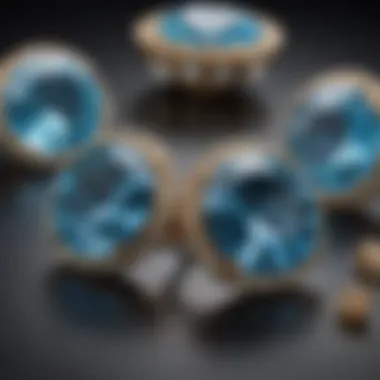
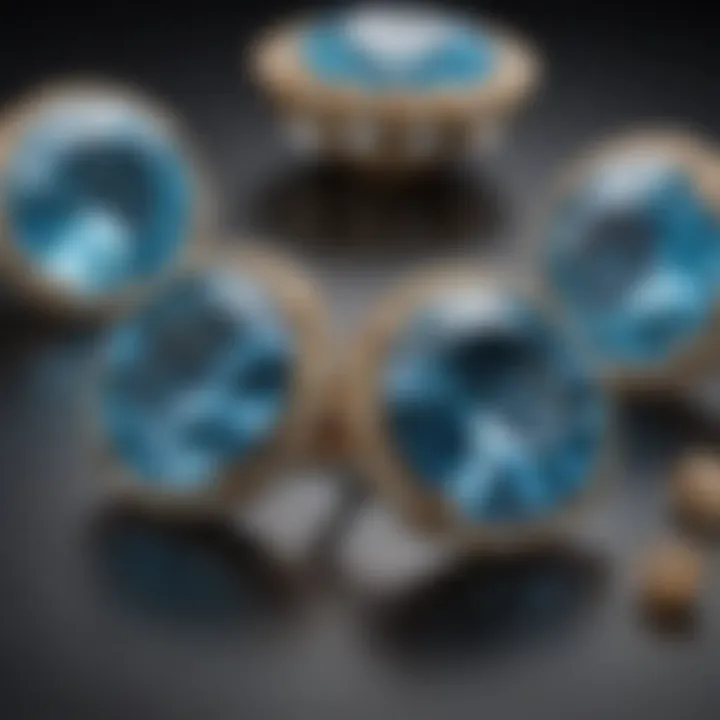
Evaluating the Gemstone's Security
When resizing jewelry, especially those featuring precious gemstones, ensuring the security of the stones must be a priority. The resizing process can inadvertently affect how well the stones are held in place, leading to potential loss. Here are some considerations:
- Types of Settings: Understand the type of setting your gemstones are in. Some settings hold stones tightly, while others may be more vulnerable during resizing. For instance, prong settings often require an extra level of care.
- Inspection Before Resizing: Have the jewelry inspected for loose stones before resizing. This prevents further complications during the process, as resizing agents may need to readjust the setting entirely.
- Post-Resizing Checkup: Once resized, never skip on a post-resizing check. This means ensuring your stones are securely placed back in their settings without any movement.
"When resizing gemstone jewelry, it’s as much about safeguarding what you have as it is about getting the perfect fit."
Being diligent about these aspects can enhance your experience and satisfaction with your resized piece. Resizing can be an opportunity to breathe new life into an heirloom, but without careful consideration, it can lead to disappointment.
Resizing Process: A Step-by-Step Guide
Understanding the resizing process is vital for anyone considering altering their gemstone jewelry. The journey to achieving the perfect fit is more than just a simple adjustment; it involves several essential stages that ensure both the structural integrity and aesthetic value of the piece are maintained. A methodical approach guarantees that all factors are taken into account, allowing for a satisfying final result. This guide delineates these stages to help you navigate the resizing process effectively.
Consultation and Assessment
The first step in the resizing journey is the consultation phase. During this stage, a professional jeweler assesses the piece in question, taking extra time to understand the specific needs of the customer. It's critical to explain how the current fit affects your experience with the jewelry. This not only contributes to assessing the required adjustments but also establishes trust and communication between the jeweler and you.
Key points to cover during consultation can include:
- Identifying problem areas: Are the rings too tight or loose?
- Discussing design complexity: Intricate pieces may need additional care.
- Evaluating stones' security: Are gemstones at risk during adjustment?
- Stones and materials: Knowing what the jewelry is made from helps determine the best resizing method. The jeweler may perform tests or use a ring mandrel to gauge size and fit accurately. Ultimately, this step lays the groundwork for a successfull resizing process.
Execution of Resizing
Once the assessment is complete and you have agreed on the best resizing strategy, the actual resizing can commence. This phase is particularly crucial because it involves precise craftsmanship. For example, if you’re working with rings, the jeweler might expand or contract the band. Depending on the complexity, they might need to:
- Cut and solder: For a significant size change, the jeweler may cut the band, alter its length, and then solder it back together, ensuring a smooth seam.
- Temporarily remove stones: If the design includes intricate gemstone settings, it’s wise for the jeweler to take them out to avoid damage during resizing, especially for softer stones like opals and pearls.
- Adjust settings: If a ring is to be enlarged, it's pivotal to ensure that the settings fit snugly, thus preventing any risk of stones becoming loose post-resizing.
This part of the process requires a steady hand and a careful eye, as any mistake could mean redoing the work altogether.
Post-Resizing Care Instructions
After the resizing is completed, the jeweler should provide you with specific care instructions to preserve the integrity of your newly resized jewelry. This guidance can vary based on the design and materials but often includes:
- Regular cleaning: Explain how best to clean the piece without harming the gemstones or altering the metal. Common methods include using mild soap and water.
- Avoiding exposure to harsh chemicals: This is particularly important for rings with delicate gemstones.
- Periodic check-ups: Noting how often you should return for professional inspections will help ensure the jewelry remains in good condition.
- Storage advice: Discuss how to properly store the jewelry to prevent tangling, scratching, or loss of stones.
"Caring for your resized jewelry is just as important as the resizing process itself. Keeping it clean and secure can prolong its life."
In summary, following these steps carefully ensures not only the quality of the resizing process but also helps maintain the beauty and functionality of your treasured gemstone jewelry. Making informed decisions at each stage can yield a piece that is not just resized, but rejuvenated.
Knowing When to Seek Professional Help
When it comes to resizing gemstone jewelry, understanding when to involve a professional can save you both time and headaches. Resizing isn’t as straightforward as one might think, especially when intricate designs or delicate stones are in the mix. Knowing when to call in an expert can mean the difference between a piece that feels custom-tailored and one that ends up looking rather haphazard.
Assessing Complex Resizing Needs
Complex resizing situations usually arise due to a variety of factors. For instance, a ring featuring not only the center gemstone but also several smaller accent stones may demand a higher level of craftsmanship when resizing. This situation is amplified if the design incorporates particular intricacies such as filigree work or a non-standard band shape. Consider this: if your jewelry is more than just a single band with a stone on it, or if it hasn’t been resized before, professional help is often wise.
Factors to consider include:
- The type of gemstones involved: Some stones can be more prone to damage, such as opals or emeralds, requiring careful handling.
- The intricacy of the design: A basic band may fare well in DIY attempts, but a more intricate design can be a minefield for the untrained.
- The age of the piece: Vintage items may have unique characteristics that a novice might overlook, leading to potential damage.
The expertise brought by a professional jeweler can provide peace of mind, ensuring that your beloved piece retains its integrity while being resized. Seeing your jewelry transformed by skilled hands can make you feel much better about the process, knowing it’s in capable care.
DIY Resizing: Risks and Considerations
Though the allure of saving a few bucks by taking to the resizing process yourself can be tempting, it’s crucial to weigh the potential drawbacks. Resizing your jewelry without the appropriate skills might just turn out to be more trouble than it’s worth. A little slip of the hand can lead to irreversible damage – like cracking a precious stone or misaligning the mount.
Here are some notable risks associated with DIY resizing:
- Permanent Damage: Certain gemstones have specific hardness levels; affecting that can result in chips or cracks.
- Incorrect Sizing: Getting the size wrong could result in needing another resizing, compounding costs and stress.
- Loss of Value: If poorly executed, the piece might lose its original value, which can be particularly worrying for vintage or inherited jewelry.
In summary, while the idea of taking on a DIY project can be exciting, particularly for those who like to dabble in hands-on activities. However, when it comes to your beloved gemstones and intricate designs, professional assistance is usually the more prudent route to safeguard both the piece and your investment.
End: Making Informed Decisions
When it comes to resizing gemstone jewelry, understanding the intricacies of costs is key for any consumer. This intersection of knowledge and awareness is vital, specifically when dealing with treasures that hold not just financial value, but sentimental resonance as well. Making informed decisions, therefore, helps mitigate potential pitfalls, ensuring that your beloved pieces are not only aesthetically pleasing but also secure and durable after alterations.
The onus falls on consumers to grasp the significant elements outlined throughout this article. From the initial assessment of resizing needs to understanding the varying costs associated with different materials and designs, each step carries implications on the final outcome of your jewelry. Not only does this knowledge afford peace of mind, but it also empowers individuals to engage in conversations with professionals confidently.
Recap of Key Points
- Factors Influencing Costs: The material of the jewelry, complexity of the design, and type of gemstone all affect the pricing. The more intricate the piece, or the different materials used, the higher the expenses may be.
- Types of Resizing Services: Blue Nile offers specialized services ranging from simple ring adjustments to more complex alterations in bracelets and earrings, making it essential to choose the right type based on specific needs.
- Average Costs: Understanding that standard pricing can fluctuate based on the factors mentioned above enables consumers to budget effectively.
- DIY Risks: The realization that certain resizing attempts should be left to professionals as complex jobs carry risks of damage is crucial for any gemstone enthusiast.
Final Recommendations for Consumers
Engaging in the resizing process should ideally come with careful consideration. Here are some recommendations to help guide your decisions:
- Consultation is Key: Always start with a professional consultation. Understand what the resizing process will entail and any potential implications on the gemstone’s integrity.
- Know Your Jewelry: Educate yourself about the materials and gemstones involved. The better you understand your piece, the more fluid your discussions will be with the jeweler.
- Research Pricing: Familiarize yourself with the costs associated with resizing similar pieces at Blue Nile and competitors to gauge fair pricing.
- Consider Your Options: If you think resizing could be overly complicated or risky, consider alternatives like wearing the piece differently or even transforming it into a new design altogether.
"Knowledge is power. In the context of jewelry resizing, it also means preserving the preciousness of your cherished pieces."
By integrating these insights into your journey, you are likely to make choices that not only respect the craftsmanship of your jewelry but also enhance your overall satisfaction with your pieces. Every step taken with diligence and thoughtfulness contributes to a rewarding resizing experience.







